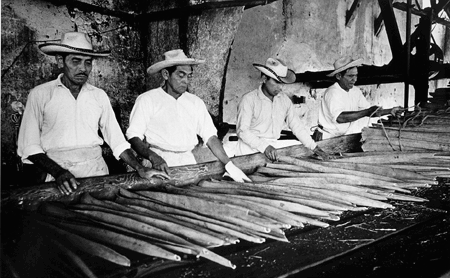The Modern Maya |
|
Henequen - The Decline of an Industry
Hacienda Holactun, 1971
|
|
| Succulent plants store water in juicy leaves, stems, or roots, and can grow under harsh conditions. The best-known plants of this family are agave, aloe, cactus, and yucca. The ancient Maya cultivated henequen (Agave fourcrodydes) for the fiber in its leaves, and used it to make an infinite number of things. Today the Maya use it for making their sandals, tools, household utensils, rope, bags, and hammocks. After Mexico's independence from Spain, the henequen industry grew and, by the 1850's, became Yucatán's principal export crop. McCormick's invention of the mechanical reaper opened up a vast market for binder twine. Almost all of the northwest Yucatán peninsula was cleared and planted. One-third of the Maya population were taken from their cornfields and forced to work in the henequen fields. The working conditions were some of the most oppressive in the Mexican republic, and the Maya were guarded by armed overseers and subjected to a brutal regimen. By 1900 Yucatán was shipping eighty-one million kilos of henequen annually. In this century, foreign competition, internal problems and new synthetic fibers have left the area poor. The Maya were freed from slavery during the Mexican Revolution, but not freed from poverty. The depressed industry is now having to cope with a labor force three times larger than needed, and the government is trying to find an alternative crop for the thin, rocky soil. | |
Overview |
The Modern Maya - book information
|
